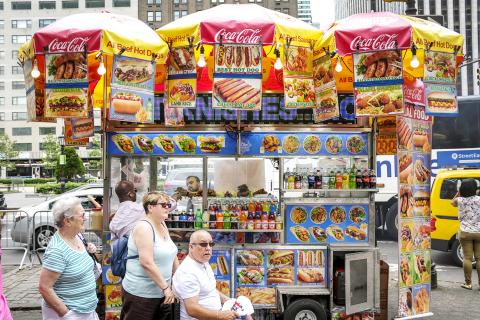Starting a food truck to sell tacos or barbecue on downtown streets may seem easy or fun, but owners are finding they need more sophisticated plans now that the novelty has worn off.
A culinary fad a decade ago, food trucks have lost some luster and even new ones may not draw a crowd. Many prospective restaurateurs now use trucks as low-cost test kitchens and as literal marketing vehicles. And food truck operators soon realize they need to think strategically especially about the winter.
Jack and Max Barber started a food truck called Mainely Burgers in 2012, selling burgers and fries at the beach in Scarborough, Maine, and the next year added a second truck in Portland and an ice cream truck. But the competition with Portland’s restaurants was tough.

Photo: AP
“We were definitely bummed out that doing the streets of Portland wasn’t working,” Jack Barber says. The brothers realized they had to change their business model. While the trucks are still a big part of the business, catering is a better way to bring in revenue.
The Barbers now have a full catering calendar, and business has been good enough that they have a restaurant in Cambridge, Massachusetts.
SLOW GROWTH
Food trucks are still appealing to chefs and entrepreneurs because they cost less than restaurants to open — tens of thousands of dollars versus hundreds of thousands or more, says John Gordon, a restaurant consultant with Pacific Management Consulting Group. That difference was particularly attractive during the Great Recession, and the cheap menus drew consumers who could get unique food for less than at a restaurant.
But trucks feel less special to customers now, particularly in big cities, restaurant consultant Clark Wolf says.
“They’re no longer a kind of secret, movable, underground treasure,” he says.
The biggest growth in the industry is past, according to market research firm IBISWorld. It counted 4,046 food trucks in the US last year, nearly twice the number of 2008. But it projects annual revenue growth of 3 percent from last year to 2022, compared to 7.3 percent from 2012 to last year, when revenue totaled nearly US$1 billion.
When Gerald and Chizuru Abraham started their Japanese food truck in Los Angeles three years ago, they were undaunted by the fact that “the glory days are over,” Gerald Abraham says.
“The heyday when trucks could pull up just about anywhere and build a line in minutes is nothing short of a fantasy to us,” he says.
But Okamoto Kitchen has been successful, and added a second truck a year ago, because the couple has chosen their menu carefully. Rather than sushi and tempura, they serve meat, fish and sandwiches using traditional Japanese flavors like ponzu.
“To survive, you have to have some sort of unique concept,” Abraham says. The couple also doesn’t bring the truck to the same locations too often so customers won’t tire of their cuisine.
But selling vegan pizza daily at the same spot, outside Buzz Mill, an Austin, Texas, bar and coffee house, works for Robbie Lordi.
“We feed their regular customers, so they don’t have to leave to eat elsewhere,” says Lordi, who started his truck, Li’l Nonna’s, two years ago. It’s common for Austin bars without their own food operations to arrange with trucks to park nearby.
Lordi also has a regular clientele, and business is growing enough that he’s considering adding a truck or opening a restaurant.
Finding a regular place has made Bruce Smith’s fried chicken truck, Chick-N-Nooga, a success — a turnaround from his first food truck, which succumbed to slow winter sales in 2013. Now Smith sells to employees of Amazon’s warehouse in Chattanooga, Tennessee, several days a week. That meant a 50 percent increase in revenue last month compared to May last year.
“Amazon is the reason I survived,” Smith says. He’s now considering whether to expand, and like Lordi, deciding whether to do so with another truck or a restaurant.
The owners’ struggles are proof that food trucks require a strategy, says Matt Geller, president of the industry group National Food Truck Association.
“If your dream is to own one food truck and make money, don’t do it,” he advises.
CATERING
Drew Pumphrey also needed a new plan. The first three years for his barbecue truck, The Smoking Swine, were tough; winters in Baltimore are lean times. But two years ago, Smith’s truck was featured on the Food Network show, “Diners, Drive-ins and Dives,” and Pumphrey began getting catering orders from companies and organizations.
“Most of that activity comes through the months when we’re not on the road that much, from November to March,” he says.
Being in the right place at the right time helps. Greg Tillery knew a food truck in New Orleans could lead to a bigger business, but “five years later I never would have guessed in my wildest dreams I would have a restaurant on Canal Street.”
Two years later, the truck, We Dat’s, had a line of 60 people waiting for chicken and shrimp at the Bayou Classic, an annual football game between Grambling State and Southern universities. Tillery realized his potential — that day led to the opening of a We Dat’s restaurant in 2016, and a second nearly a year ago.
The vision Natasha Case and Freya Estreller had was ice cream trucks in different cities across the country. They ended up with a brand of ice cream in 6,000 grocery stores.
Case and Estreller founded Coolhaus with one food truck in Los Angeles in 2009. Within a few years, they had a handful of trucks in the city, Dallas and New York. They also began test-marketing their ice cream at Whole Foods, and realized the best way to go national was selling ice cream in grocery stores.
The trucks, which now number nine, and three stores in Southern California are laboratories, Case says.
“We can build a following before we bring our products to grocery stores,” she says.

The depressing numbers continue to pile up, like casualty lists after a lost battle. This week, after the government announced the 19th straight month of population decline, the Ministry of the Interior said that Taiwan is expected to lose 6.67 million workers in two waves of retirement over the next 15 years. According to the Ministry of Labor (MOL), Taiwan has a workforce of 11.6 million (as of July). The over-15 population was 20.244 million last year. EARLY RETIREMENT Early retirement is going to make these waves a tsunami. According to the Directorate General of Budget Accounting and Statistics (DGBAS), the

Many will be surprised to discover that the electoral voting numbers in recent elections do not entirely line up with what the actual voting results show. Swing voters decide elections, but in recent elections, the results offer a different and surprisingly consistent message. And there is one overarching theme: a very democratic preference for balance. SOME CAVEATS Putting a number on the number of swing voters is surprisingly slippery. Because swing voters favor different parties depending on the type of election, it is hard to separate die-hard voters leaning towards one party or the other. Complicating matters is that some voters are

Sept 22 to Sept 28 Hsu Hsih (許石) never forgot the international student gathering he attended in Japan, where participants were asked to sing a folk song from their homeland. When it came to the Taiwanese students, they looked at each other, unable to recall a single tune. Taiwan doesn’t have folk songs, they said. Their classmates were incredulous: “How can that be? How can a place have no folk songs?” The experience deeply embarrassed Hsu, who was studying music. After returning to Taiwan in 1946, he set out to collect the island’s forgotten tunes, from Hoklo (Taiwanese) epics to operatic

Five years ago, on the verge of the first COVID lockdown, I wrote an article asking what seemed to be an extremely niche question: why do some people invert their controls when playing 3D games? A majority of players push down on the controller to make their onscreen character look down, and up to make them look up. But there is a sizable minority who do the opposite, controlling their avatars like a pilot controls a plane, pulling back to go up. For most modern games, this requires going into the settings and reconfiguring the default controls. Why do they